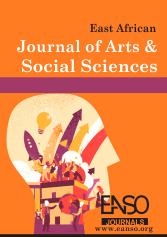Binding Connectivity in Kipsigis Copula Clauses
Abstract
Research in language typology is geared towards explaining and describing the facts of natural language structure. Several linguists have developed an interest in the study of copula clauses in various languages. In linguistics, a copula (plural copulas or copulae; abbreviated COP) is a word or phrase that links the subject of a sentence to a subject complement. This study aimed to investigate the binding connectivity of copula clauses in Kipsigis. Kipsigis is a Nilo-Saharan language of the Kalenjin language subgroup spoken by approximately 1.9 million people, according to the 2019 Census. The Kipsigis are the southernmost of the Kalenjin people. They inhabit the current administrative counties of Kericho and Bomet, but they also live in parts of Nakuru, Nandi, Uasin Gishu and Narok counties. The main objective of the study was to investigate the binding connectivity of Kipsigis copula clauses. This research was based on Chomsky’s Minimalist program, which has a track record of effectively analysing diverse language structures. As a result, it appears reasonable to apply this model to investigate copula clauses in the Kipsigis dialect. The approach emphasises using concise representations in linguistic analysis and descriptions, ensuring that syntactic specifications and derivational procedures contain only the necessary elements. The study adopted a descriptive research design and the data was collected through self-introspection and triangulation. This study established that Kipsigis has only one copula element ko. In the literature of Binding theory, binding principles do not apply to Kipsigis copula clauses, where the two phrases flanking the copula come into the structure with the same index. It also shows that Kipsigis copula clauses exhibit different behaviour with regard to copula constructions. That is, connecting two referential expressions with the copula means that the same reference is given to both of them hence violating the principles of Binding Theory. This implies that the study of any human language is important for its own sake. The findings from this study can be also used in linguistic analysis of copula clauses in future studies.
Downloads
References
Amary-Coudreau, V. (2012). (XP), c’est terrible. Un cas de phrase spécificationnelle. SHS Web of Conferences, 1, 2279–2301. 3ème Congrès Mondial de Linguistique Française, Lyon. https://doi.org/10.1051/shsconf/20120100063
Cecchetto, C., & Donati, C. (2007). On labeling: Principle C and head movement. In V. Moscati (Ed.), CISCL Working Papers on Language and Cognition (Vol. 1, pp. 16–37). STiL Studies in Linguistics. https://doi.org/10.1111/j.1467-9612.2010.00140.x
Chomsky, N. (1981). Lectures on government and binding. Foris Publications.
Chesaina, C. (1991). Oral literature of the Kalenjin. Heinemann Kenya.
Dahl, O. (1981). Binding relations in dislocated constituents. Talk presented at the Sloan Workshop on Alternatives to Transformational Grammar, Stanford University.
Diercks, M. (2019). Word order and information structure in Kipsigis. Linguistic Inquiry, 50(4), 723-756.
Fiengo, R., & May, R. (1994). Indices and identity. MIT Press.
Frege, G. (1892). Über Sinn und Bedeutung. Zeitschrift für Philosophie und philosophische Kritik, 100, 25–50.
Heim, I., & Kratzer, A. (1998). Semantics in generative grammar. Blackwell.
Higgins, R. F. (1979). The pseudo-cleft construction in English. Garland.
Jacobson, P. (1994). Binding connectivity in copula sentences. In Semantics and Linguistic Theory (Vol. 4, pp. 161–178).
Kibet, M. (2014). Verbal extensions in Kipsigis: A morphosyntactic analysis. [Master’s thesis, University of Nairobi].
Kouneli, M. (2019). Plurality and grammatical gender in Kipsigis. [Doctoral dissertation, New York University].
Lakoff, G. (1970). Repartee. Foundations of Language, 6, 389–422.
Macià, J. (1996). Binding theory, semantic interpretation, and context. CatWPL, 5(11), 81–112.
May, R. (1985). Logical form: Its structure and derivation. MIT Press.
Patton, M. Q. (1999). Enhancing the quality and credibility of qualitative analysis. Health Services Research, 34(5 Pt 2), 1189–1208.
Pereltsvaig, A. (2001). On the nature of the intra-clausal relations: A study of copular sentences in Russian and Italian (Doctoral dissertation, McGill University, Montréal).
Ruys, E. G. (2000). Weak crossover as a scope phenomenon. Linguistic Inquiry, 31(3), 513–539.
Schlenker, P. (2003). Clausal equations (A note on the connectivity problem). Natural Language and Linguistic Theory, 21, 157–214.
Towett, J. K. (1979). A study of Kalenjin linguistics. Kenya Literature Bureau.
Copyright (c) 2025 Vincent Kiplangat, Peter Muriungi, PhD, Mary Karuri, PhD

This work is licensed under a Creative Commons Attribution 4.0 International License.




























